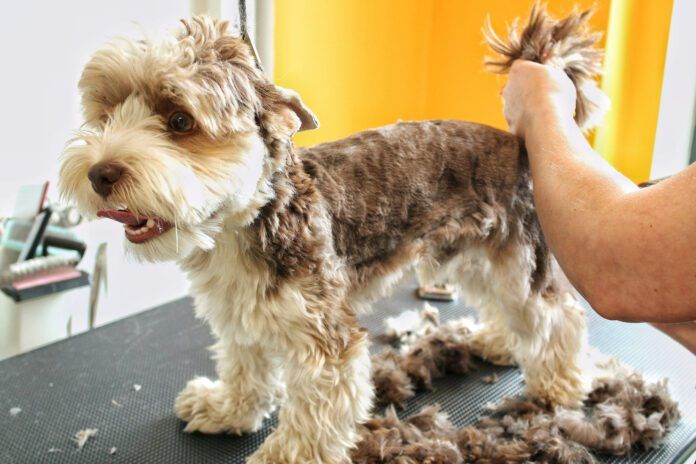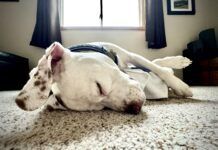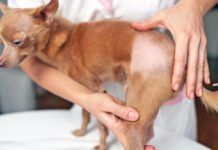The word furunculosis sounds ugly and gross, which perfectly describes this skin condition, which grows under your dog’s fur.
Furunculosis appears as red bumps under the skin. They are inflamed, generally painful, and may have a purulent or puslike exudate. You may hear a furunculosis bump called a dog boil. While furunculosis is a deep-seated bacterial infection that usually starts in hair follicles, it is not folliculitis. Folliculitis is a superficial bacterial infection.
Furunculosis can occur in different areas and often involves Pseudomonas species of bacteria. Pseudomonas species are notoriously difficult to eradicate and nasty pathogens.
Likely Spots for Furunculosis in Dogs
The four usual areas where you may see furunculosis are:
- Muzzle/face
- Interdigital (between toes)
- Anal
- Body (less commonly, often post grooming)
These all look similar but have varying degrees of difficulty to clear.
Bumps on Dog’s Face
The muzzle/face cases tend to be in young dogs. They start out looking like classic puppy chin acne. Some pimples, a little redness, and your pup may rub his face a bit. Unfortunately, this then becomes a deeper infection. Inflammation, purulent discharge, and pain are common. Demodex must be ruled out as a possible cause.
For mild cases caught early, topical therapy may work. That means cleaning the area well, then drying it thoroughly as moisture simply encourages the infection. A topical antibiotic cream may work, though many dogs will require an oral antibiotic. Painful pups will benefit from an anti-inflammatory.
If you feel bumps on your dog’s body, they may be something as mild as hives. Most cases of hives are mild, come up quickly, and are smooth and round. They tend to respond to a dose of antihistamine or will resolve on their own over a matter of hours.
Inflamed Toes on Dog
Interdigital furunculosis can start as allergies affecting the area between the toes. Mild yeast infections provide a moist, inflamed setting for bacteria to flourish. Some cases start with foreign bodies, like plant material such as foxtails, penetrating the skin and creating a sore. Any irritant to the foot can start the cycle of inflammation that leads to infection.
Interdigital cysts and autoimmune conditions are behind some cases of foot furunculosis. This problem is more common in dogs with short hair (think Weimaraners), but Labrador Retrievers and Bulldogs seem to get this problem more than other breeds as well. Hypothyroidism and Cushing’s disease may be contributing factors as well due to their influence on the immune system. Just one area may be affected or the whole paw.
You may notice your dog limping, holding up a paw, or licking excessively at his feet. Some owners can pick up an obnoxious odor. This can be painful, and your dog may resist you handling his paws.
Warm water soaks with Epsom salts help with healing and provide some comfort. If your dog resists keeping a paw in a small bucket, put a couple inches of warm water in the bathtub with some Epsom salts. Chlorhexidine can be used in soaks as well.
Post soak, thoroughly dry the paws. Any moisture simply makes it a good place for yeast and bacteria to thrive. I then apply foot powder. Most foot powders are antibacterial, antifungal, anti-inflammatory, reduce itching, and taste bad. Ointments and creams often simply encourage more licking, requiring the use of a cone to stop the dog from licking.
Some foot infections will require oral antibiotics or antifungal medications. For stubborn cases, your veterinarian may do a culture and sensitivity. Your dog may also need bloodwork for autoimmune diseases and a thorough exam for any foreign bodies. Pain medications may be necessary to keep your dog comfortable. Laser surgery can be used for resistant cases.
Perianal Fistulas
The worst cases of furunculosis are perianal fistulas. While up to 80% of cases are seen in German Shepherd Dogs, these fistulas can occur in other dogs as well. The classic case is a middle-age, intact male dog. Originally, the blame was put on the thick tail of shepherds, which tends to be carried down, so the anal area does not air out and dry. Now, it is felt that this is more of an immune problem.
Owners may notice their dog having trouble defecating, straining, some bloody discharge on stools, even whining in pain when eliminating. There may be discharge noted on bedding and a foul odor from the rear of the dog. Initially dogs may “scoot” their rear, like with an anal-gland problem. Some dogs will have diarrhea or constipation, and all dogs will lick the area excessively.
Sedation may be required for a thorough exam. A rectal will be necessary, partly to see if the anal glands are involved.
This can be a very frustrating problem to treat. Medical therapy is tried first. An oral immune suppressant such as cyclosporine is often the first step, along with antibiotics for the bacterial infection that is virtually always present. Your dog may end up on medications long term, perhaps with brief periods of remission. Recurrence can be up to 50%, if you get it cleared at all.
If medical therapy does not work, cryosurgery or laser surgery can be attempted. Some veterinarians feel tail amputation may help to aerate the area.
Many cases seem to be associated with inflammatory bowel disease so dietary changes may help.
Post-Grooming Furunculosis
Furunculosis that shows up post grooming tends to be on the back and may spread to the sides of your dog. You will feel raised areas that are often painful and crusty from inflammatory and purulent exudates. This will happen within days of grooming, usually after clipping. While dirty tools are a possibility, most groomers practice excellent hygiene. Your dog may have sensitive skin, so he reacts to the shampoo or conditioner, or he may have had a skin problem brewing which the grooming just accentuated.
These cases are painful and require a veterinary visit. A culture and sensitivity may be recommended right off the bat for bad cases. Antibiotics and pain medications are usually dispensed.
Preventing Furunculosis in Your Dog
Avoiding furunculosis in your dog partly comes down to good genetics. A dog with a good immune system will often throw off these infections before they get out of hand. It behooves you to keep your dog in the best possible shape, doing all recommended preventive care, providing good nutrition, and being observant so you can catch any problems early on.






